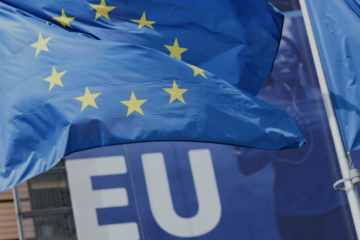It is cold this time of year at the Belarusian-Polish border. The temperatures barely rise above 0ºC, and it freezes at night. Yet, thousands of migrants are stuck with barely any support. Human rights groups claim at least 13 people died at the border between September and December 2021. With the resurgence of Covid-19 within the European Union, the attention of governments and the media shifts away, and the migrants at risk are forgotten. Yet, a solution to the crisis seems difficult to find.
Since summer 2021, the number of migrants trying to cross the Belarusian-Polish border has increased dramatically, turning it into a hotspot of European migration. Frontex, the European Border and Coast Guard Agency, registered 8,000 illegal border crossings, which is more than a tenfold increase compared to 2020. The number of possible asylum seekers entering Latvia and Lithuania via the Belarusian border has also risen sharply, but the focus is currently shifting more and more to Poland. Both the EU governments and the European Commission accuse Belarusian President Alexander Lukashenko of attracting migrants from the Middle East, in particular from Iraq, and helping them to reach Europe’s external borders, in an attempt to use them as leverage against existing EU sanctions. This Belarusian hybrid attack, they claim, is a form of human smuggling and trafficking, which instrumentalises people for political ends.
The European Commission responded to Lukashenko’s actions with sanctions. In addition, it urged international airlines to stop flying possible asylum seekers to Belarus. This prompted some airlines to suspend flights to Belarus entirely, further isolating the country on a geopolitical level. At the same time, Poland continued to securitise its border; declaring a state of emergency enabled the Polish government to use exceptional measures, including not only an increased military presence at the border and the temporary closure of checkpoints, but also a ban on journalists and activists entering the border zone. Consequently, impartial coverage of the crisis is rare to come across, which makes it difficult to estimate the number of migrants, assess their health conditions or monitor the security forces. The need for closer monitoring is demonstrated by an Amnesty International investigation that uncovered push-backs by Polish forces, in violation of international law.
The EU announced at the beginning of December that the situation is under control and the number of incoming migrants is now very limited – the relocation to their countries of origin has begun. In addition, the Polish government lifted the ban on journalists and announced its intention to organise guided visits and to set up a press centre at the border. However, the International Organisation for Migration estimates that around 7,000 migrants remain in Belarus, most of them unwilling to return. Their future remains uncertain.
The full dimension and underlying strategies of both sides within the current crisis is overlooked. The word crisis implies loss of control, danger or fear. By calling the recent events a migration crisis, these notions are transferred to migrants themselves, who are seen as actively causing the crisis rather than suffering from the decisions of Belarus and the EU. In addition, it is imprecise to call the events unfolding on the EU’s doorstep a migration crisis. Although estimates vary, there might be less than 25,000 migrants who have crossed the border between Belarus and an EU member state, or are still stuck in Belarus, attempting to cross. This number is shockingly little compared to over 26 million refugees worldwide or the 2.5 million asylum claims within the EU recorded in the years 2015 and 2016.
The term ‘migration crisis’ thus is an exaggeration of what is happening. The number, however, stands for thousands of individuals deprived of their basic human rights, left at the mercy of a president often referred to as ‘Europe’s last dictator’, whom the EU does not officially recognise and accuses of election fraud and human rights violations. This tragedy is overlooked in the migration-security nexus. The term crisis of humanity aptly describes this.
Securitising migration is not a recent phenomenon within the EU. The origins trace back at least to the 1990s. Within the last 30 years, member states have strengthened their cooperation on trade, created the Schengen area, and enhanced freedom of movement across borders. Yet, they simultaneously strengthened the Union’s external border control and immigration policies. Legal migration routes are often limited to specific economic areas, such as health and elderly care, while asylum seekers and refugees are doomed to use dangerous irregular routes, for example across the Mediterranean Sea or the Balkans, with the help of smugglers. Europe’s 2015 refugee crisis marked the starting point of the most recent aggravation.
The current credo from most European leaders seems clear: no repetition of 2015, no matter the costs. The fear of a further rising populist and anti-immigration movement, and the embrace of anti-immigration rhetoric by political leaders in various EU member states, is omnipresent. NGOs and members of the European Parliament both accuse the Commission and Poland of using the recent events as an excuse to further lower the EU’s migration standards.
The security-migration nexus might explain Lukashenko’s strategy. Migrants are used as a strategic tool to leverage the country’s interests towards the EU. Professor Kelly Greenhill uses the term ‘coercive engineered migration’ to describe the deliberate creation of border movements that pressure the targeted state for political, economic or military concessions. Sending people to the EU border, who themselves have no other way of entering the EU given the lack of legislation, thus seems promising for Lukashenko. Especially, as it has worked in past decades. For instance, in 2002, President Lukashenko repeatedly urged the EU to reimburse Belarusian efforts to stop illegal migration. He repeated these claims in 2004 and managed to increase the EU’s financial support.
To date, however, his tactic was not successful in the recent episode, but rather increased the sanctions Belarus is already facing, imposed by the EU after the Belarusian presidential election fraud in 2020, and the 2021 forced landing of a Ryanair flight in Minsk in order to detain opposition journalist Roman Protasevich. Lukashenko agreed to resettle migrants into heated warehouses and to offer flights to their countries of origin. However, he also announced that Belarus will not force the repatriation of those who want to enter the EU. It seems to be a matter of time before the conflict escalates again, with an adapted strategy.
It is time to turn attention to the individuals that are deprived of basic rights. There is a way to overcome the current crisis without appeasing Lukashenko: the EU member states, and Poland in particular, could simply agree to open the Union’s external border and process asylum claims, or at least provide medical assistance. The EU is economically capable to do so and more than enough European cities and communities have pledged their willingness. Yet, this solution is not even discussed – it simply is not an option for the EU and its member states, who continue to centre their thinking around the migration-security nexus. For instance, in October, the Polish parliament approved the government’s proposal to build a 100 km long wall at the border with an estimated cost of 350 million euros, and in December, the EU Commission proposed to temporarily reduce asylum standards. And in early January 2022, Médecins Sans Frontières left the area, accusing the Polish government of preventing access to people in need of help.
Therefore, without fundamental reform of European migration policies the EU will likely continue to be at the mercy of its bordering countries, including regimes with poor human rights records such as Belarus, Libya, or Turkey. Such reforms first and foremost need to introduce legal ways for refugees to immigrate into EU countries, for example through a broadened participation in UNHCR’s resettlement program or a distinguished visa for asylum claims as proposed by the European Parliament in 2018, which could establish a mandatory distribution mechanism between member states. However, a sustainable long term solution seems unlikely, as Eastern European member states have incentives to prevent reforms that would increase their respective share of responsibility.


